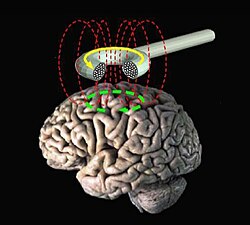Transcranial magnetic stimulation

Transcranial magnetic stimulation (TMS) is a special kind of therapy that helps people who have problems with their brain. This therapy uses a magnetic field to stimulate or activate some specific parts of the brain which are not working well. It's called 'transcranial' because the magnetic field is applied from outside the head, and 'stimulation' because it encourages brain cells to become more active.
To do this, a doctor or a therapist uses a special machine that produces a magnetic field. This machine has a wand that is placed on the scalp, like a big shiny pencil. The wand sends the magnetic field through the scalp and skull and into the brain, where it activates certain neurons or brain cells. This electrical stimulation helps to improve brain function, such as in cases where someone has depression or anxiety.
Think of your brain like a big garden. Sometimes, the flowers don't grow properly and need some help to bloom. TMS is like adding water and sunlight to the flowers to help them grow. The doctor or therapist can measure where the wand should be placed on someone's head by using special machines to check the person's brain activity. The wand will only be placed in safe places and for a short amount of time.
This therapy is very helpful as it targets a specific part of the brain that needs attention. It is also non-invasive, which means that the patient doesn't need any surgery or anesthesia. Patients might feel some mild discomfort or a tapping sensation during the therapy, but it doesn't hurt.
Overall, TMS is a special kind of therapy that uses a magnetic field to stimulate or activate certain parts of the brain that aren't working properly. It is like adding water and sunlight to help flowers grow. It is safe and non-invasive, and is very helpful in treating certain mental health conditions.
To do this, a doctor or a therapist uses a special machine that produces a magnetic field. This machine has a wand that is placed on the scalp, like a big shiny pencil. The wand sends the magnetic field through the scalp and skull and into the brain, where it activates certain neurons or brain cells. This electrical stimulation helps to improve brain function, such as in cases where someone has depression or anxiety.
Think of your brain like a big garden. Sometimes, the flowers don't grow properly and need some help to bloom. TMS is like adding water and sunlight to the flowers to help them grow. The doctor or therapist can measure where the wand should be placed on someone's head by using special machines to check the person's brain activity. The wand will only be placed in safe places and for a short amount of time.
This therapy is very helpful as it targets a specific part of the brain that needs attention. It is also non-invasive, which means that the patient doesn't need any surgery or anesthesia. Patients might feel some mild discomfort or a tapping sensation during the therapy, but it doesn't hurt.
Overall, TMS is a special kind of therapy that uses a magnetic field to stimulate or activate certain parts of the brain that aren't working properly. It is like adding water and sunlight to help flowers grow. It is safe and non-invasive, and is very helpful in treating certain mental health conditions.
Related topics others have asked about:
Cortical stimulation mapping,
Cranial electrotherapy stimulation,
Electrical brain stimulation,
Electroconvulsive therapy,
Low field magnetic stimulation,
My Beautiful Broken Brain,
Neuromodulation (medicine),
Neurostimulation,
Neurotechnology,
Non-invasive cerebellar stimulation,
Transcranial alternating current stimulation,
Transcranial direct-current stimulation
